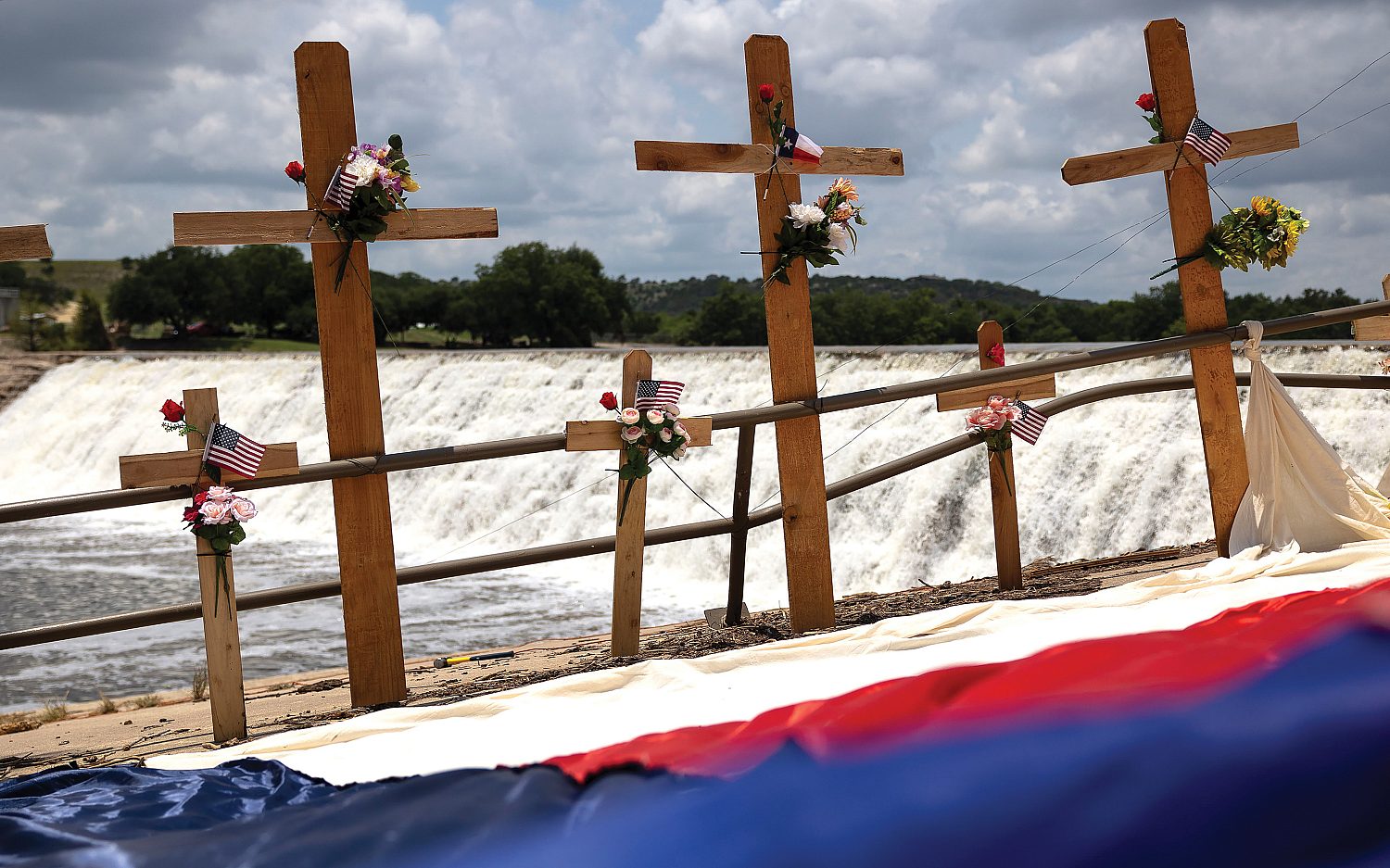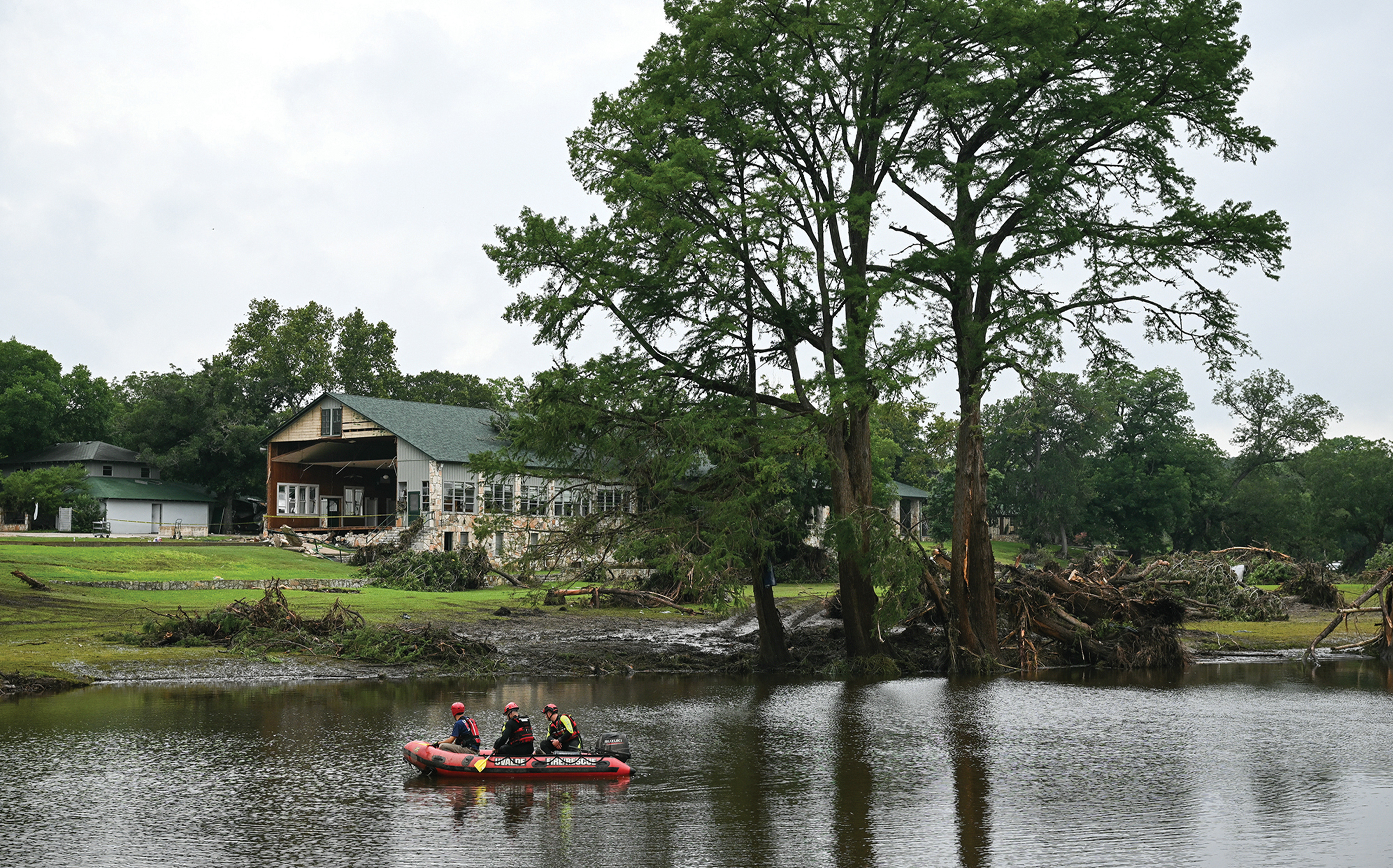Troubled waters
IN THE NEWS | In the aftermath of catastrophic flooding, Texas grapples with questions about how to prevent future tragedy
Wooden crosses stand as a memorial on the bank of the Guadalupe River in Kerrville. Xu Jianmei Xinhua / Eyevine / Redux

Full access isn’t far.
We can’t release more of our sound journalism without a subscription, but we can make it easy for you to come aboard.
Get started for as low as $3.99 per month.
Current WORLD subscribers can log in to access content. Just go to "SIGN IN" at the top right.
LET'S GOAlready a member? Sign in.
Kerrville City Attorney Mike Hayes checked the weather on his iPhone before climbing into bed on the evening of July 3. He remembers telling his wife it looked like the predicted thunderstorm might pass them by without interfering with the city’s annual Fourth of July festival along the river. The couple had signed up to man a booth the next morning. “Storms come out of the west, and they kind of just break up over our hills,” he told me. “And we just don’t get the rain that other people around us do.”
Kirk Marchand, who attends Christ Church Presbyterian with Hayes, rose early Friday morning, intending to watch the sunrise from his back patio. Instead, he sat watching it rain—hard. He heard what he thought were fireworks but finally realized it was trees snapping as a 26-foot wall of water thundered down the Guadalupe River. The normally calm waterway rose within minutes, with the worst of the flooding occurring between 4 a.m. and 6 a.m. The raging torrent surged through summer camps, mobile homes, and RV parks.
At least 132 people are confirmed dead, but as of 10 days after the disaster, 101 people were still missing.
Kerr County, of which Kerrville is the county seat, bore the brunt of the fatalities, although many of the victims were only visiting the area. At least 106 people perished there, including at least 36 children. Twenty-seven of the victims came from Camp Mystic, an all-girls Christian summer camp.
Local residents sifting through the wreckage and reckoning with their own losses are also grappling with a sense of guilt that the flood snuffed out the lives of so many visitors. While churches and ministries help residents come to terms with the reality of the inexplicable catastrophe, Kerr County and the surrounding Texas Hill Country—an area known as “flash flood alley”—are confronting difficult questions about how to minimize future flood disasters.
Hayes, his wife, and three children moved to the artsy, outdoorsy community 25 years ago. “Everyone had kayaks on top of their cars,” he recalled. “We’re drawn to the water. … It’s life-giving.” The Guadalupe River, typically a gentle, slow-moving presence, snakes its way through the center of town. The city of almost 25,000 is known for the beautiful parks that line the riverway and come alive with visitors during the community’s Independence Day celebration.
The community is one of many nestled along the Guadalupe River and its tributaries throughout the Texas Hill Country, one of the most flood-prone regions in the United States. In 1987, 10 teenagers died downriver in Comfort when a flash flood stranded a church bus and van. As far back as the 1840s, the Germans who settled the area dealt with their share of sudden floods.

A search-and-rescue team looks for people along the Guadalupe River near a damaged building at Camp Mystic. Ronaldo Schemidt / AFP via Getty Images
The area’s distinct topography makes it especially vulnerable. “You’ve got a lot of creeks and streams and river valleys at the base of those hills,” said Dan Pydynowski, a senior meteorologist at AccuWeather. “The soil is generally thin and dry and dusty and doesn’t absorb moisture and rainfall easily.” Underneath is a layer of slick limestone, so heavy rainfall doesn’t have anywhere to go, Pydynowski said. That causes creaks and streams to become “raging rivers and raging walls of water very quickly.”
Local meteorologist Daniel Schreiber said these factors, coupled with a stationary storm system that dumped torrential rainfall in the dead of night, created the ideal conditions for an extreme flooding event. “The procedures that were followed by the meteorologists that were forecasting this event from the National Weather Service … went as well as they could,” Schreiber said. “Where there was a disconnect, I believe, [was] whether or not those warnings were actually reaching the people that they needed to reach.”
The National Weather Service’s Austin/San Antonio office issued flash flood warnings during the night of July 3 and into the early morning of July 4, “giving preliminary lead times of more than three hours before warning criteria were met,” according to a timeline and statement the agency gave me. Level 2 or 3 flash flood warnings trigger the Federal Emergency Management Agency’s Wireless Emergency Alert system, which pings individuals’ phones if they have those alerts turned on.
But parts of Kerr County lack cell service, Hayes told me, and even if people received the warnings, many likely weren’t paying attention after midnight. Locals are also inundated with warnings. Officials have issued at least 300 flood advisories or warnings for Kerr County since 2015, according to Schreiber. “We’re very used to getting weather watches and then not a whole lot of weather occurring,” he said.
At Camp Mystic, director Dick Eastland received an initial flood alert at 1:14 a.m., but camp staff didn’t begin evacuating campers until at least 45 minutes later, when conditions had worsened. A family spokesman told ABC News the alert was “a standard run-of-the-mill NWS warning that they’ve seen dozens of times before.”
In the flood’s immediate aftermath, reports surfaced that Kerr County had considered a warning system including river sirens and gauges almost a decade earlier. Minutes from a Jan. 9, 2017, commission meeting show the project would have cost an estimated $976,000. Then-County Commissioner Tom Moser noted during the meeting that many residents opposed sirens and that improved water level monitoring wasn’t worth the cost if officials didn’t also find ways to more effectively alert the public.
Parts of the Guadalupe River already have sirens, but officials ultimately rejected the project due to the price tag after the state’s Division of Emergency Management, which screens FEMA grant requests, shot down Kerr County’s proposal, according to a spokesperson quoted by The New York Times. Schreiber, the Texas meteorologist, said that stormy weather makes it difficult to hear a siren depending on an individual’s location. Deep sleep, white noise machines, and the sound of rushing water also complicate things.
“We live by the water. We take on risks,” said Hayes, the city attorney. “I see very strenuous, robust, lengthy conversations about what to do, down to the dime. And sometimes it’s just this balance.” But Hayes hopes future analysis includes conversations about how close to the river the city builds structures.
Experts argue pinpointing where torrential rainfall will occur could help small communities to evacuate before flood warnings are issued. Alan Gerard, a retired meteorologist with the National Oceanic and Atmospheric Administration, said higher resolution computer modeling could improve forecasting of intense rainfall events. “That would help people start to make more proactive decisions,” Gerard said. But that capability is likely years away.
In Kerrville, Pastor Billy Crain and Christ Church Presbyterian’s elders, Mike Hayes among them, divided up the church directory and began checking on its roughly 80 members. While some members suffered minor flooding damage to property, none died and homes were still mostly intact. But the grief remains palpable.
“This town has a lot of connections to the rest of the state,” Crain said. “One of the things I’m wanting to get across to people first is: them being heartbroken, them being sad, them grieving? That is the most normal and rational and right human response to this situation.”
—This story was corrected Aug. 19 to reflect that Kerrville is situated along the Guadalupe River, which empties directly into the gulf.

Please wait while we load the latest comments...
Comments
Please register, subscribe, or log in to comment on this article.